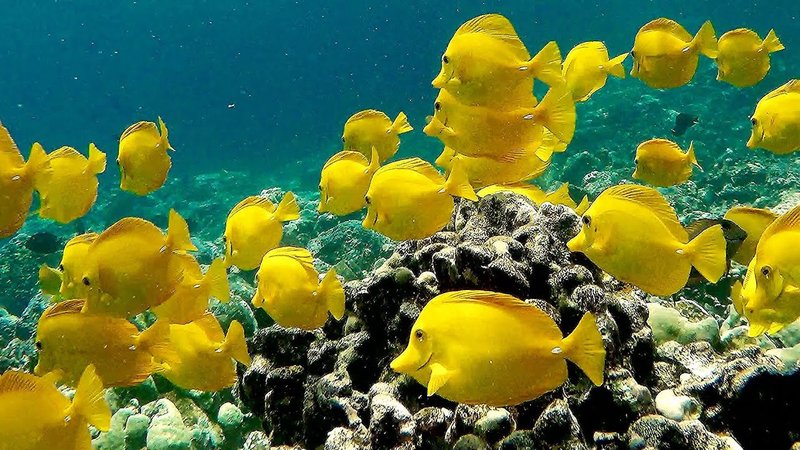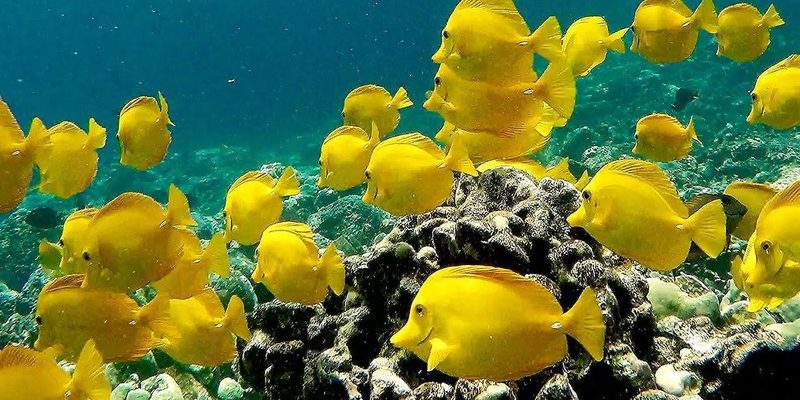
Yellow tangs are primarily found in the warm waters of the Pacific Ocean, specifically around coral reefs. Think of coral reefs as the underwater cities of the ocean. These reefs provide shelter and food for yellow tangs, making them a vital part of their ecosystem. In this article, we’ll take a closer look at where these fish are found, what kind of environments they call home, and why their habitats are so important.
Understanding the Yellow Tang’s Habitat
The yellow tang (Zebrasoma flavescens) is often found in shallow waters, typically at depths ranging from 1 to 40 meters (about 3 to 130 feet). They prefer coral-rich areas where food is abundant and shelter is plentiful. These vibrant fish are particularly common in the Hawaiian Islands, where the warm waters are perfect for their survival.
Coral Reefs: Nature’s Underwater Cities
Coral reefs are more than just colorful structures; they serve as a crucial habitat for yellow tangs. The reefs provide a variety of algae, which is a primary food source for these fish. When swimming around the reefs, yellow tangs graze on the algae, helping to keep the coral healthy. It’s a little bit like going to a salad bar—lots of choices and a tasty menu!
In addition to food, coral reefs offer protection from predators. The nooks and crannies of the reef provide hiding spots, allowing yellow tangs to escape larger fish that may see them as a meal. This relationship showcases how interconnected ocean life is. Healthy reefs mean healthy fish, and vice versa.
Geographical Distribution of Yellow Tangs
Yellow tangs are native to the central and western Pacific Ocean. Some of the most notable locations where they are commonly spotted include:
- Hawaiian Islands: This is the heart of yellow tang territory. The warm, nutrient-rich waters provide the perfect environment.
- Johnston Atoll: Located southwest of Hawaii, this atoll has thriving coral reefs that support diverse marine life.
- Tuamotu Archipelago: This group of islands in French Polynesia is another hotspot for yellow tangs.
These regions are known for their vibrant ecosystems, and they offer the right conditions for yellow tangs to grow and reproduce. You might be wondering how these fish adapt to different areas. They’re pretty resilient, often adjusting to the local environment while still seeking out their preferred habitats.
The Importance of Coral Reefs to Yellow Tangs
Coral reefs are crucial for the survival of yellow tangs. As I mentioned earlier, they provide food and shelter, but there’s more to the story. Healthy coral reefs are vital for the entire marine ecosystem. When these reefs are in good shape, they support countless species, helping maintain the balance of ocean life.
Unfortunately, coral reefs around the world are facing serious threats from climate change, pollution, and overfishing. This is a big deal because if reefs decline, yellow tang populations can also suffer. So, protecting these habitats is not just about saving one species—it’s about safeguarding the entire marine community.
Yellow Tangs in Aquariums: A Brief Overview
If you’re thinking about keeping yellow tangs as pets, you’re not alone! They’re popular in home aquariums because of their beautiful color and lively behavior. However, it’s important to recreate their natural habitat as closely as possible.
Creating the Right Environment
To properly care for a yellow tang, an aquarium should ideally mimic a coral reef environment. Here are some tips:
- Provide plenty of live rock for grazing and hiding.
- Maintain stable water temperatures (around 75°F to 82°F).
- Ensure good water quality and filtration, as yellow tangs are sensitive to poor conditions.
Creating a suitable environment can make a huge difference in their overall health and happiness. Think of it like giving them a cozy home where they can thrive.
Common Challenges Facing Yellow Tangs
Even in the wild, yellow tangs face challenges that can impact their populations. One common issue is overfishing. Because they are so sought after in the aquarium trade, many yellow tangs are caught and sold. When this happens at unsustainable levels, it can deplete wild populations.
Climate Change and Its Impact
Another significant challenge is climate change. As ocean temperatures rise, coral reefs can experience bleaching, which affects the habitats of yellow tangs. Bleached reefs struggle to provide the necessary food and shelter these fish need to survive.
This raises a crucial point: protecting yellow tangs means we must also focus on preserving their natural environments. It’s a complicated dance, and we all play a part in it.
What You Can Do to Help
So, how can you contribute to the health of yellow tangs and their habitats? Here are some actions you can take:
- Support sustainable fishing: Choose seafood that comes from well-managed fisheries.
- Help reduce pollution: Participate in local clean-up events and reduce plastic use to protect ocean ecosystems.
- Learn and educate: Share information about the importance of coral reefs and marine life with friends and family.
Making small changes in our daily lives can lead to big impacts for yellow tangs and their habitats. Together, we can help ensure these beautiful fish continue to thrive in our oceans.
Concluding Thoughts on Yellow Tangs
Yellow tangs are more than just pretty fish; they’re a vital part of the ocean’s ecosystem. Their habitats, primarily thriving coral reefs, play an essential role in their survival and in maintaining the balance of marine life. By understanding where yellow tangs are found and the challenges they face, we can better appreciate these incredible creatures.
Whether you’re an aquarium enthusiast or just someone who loves marine life, remember that every little action counts. By caring for the environment and supporting sustainable practices, we can help protect yellow tangs and the amazing homes they rely on.

